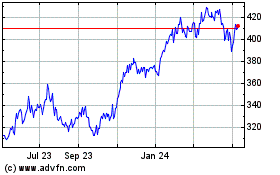Microsoft Makes Gains On the Cloud -- WSJ
April 28 2017 - 3:02AM
Dow Jones News
By Jay Greene
Microsoft Corp.'s cloud business surged in the fiscal third
quarter, continuing the company's transition from legacy vendor of
packaged software to a leader in the booming business of web-based,
on-demand computing.
Microsoft's Azure business again posted torrid growth as
corporate customers adopt the cloud service to handle larger pieces
of their computing operations. And Office 365, the online version
of Microsoft's widely used productivity software, reported huge
gains as well as businesses increasingly subscribe to email,
word-processing and spreadsheet applications that run in
Microsoft's data centers.
Even as the Windows operating-system franchise continues to
generate big profits, the cloud gains are crucial as Microsoft
battles Amazon.com Inc. and Alphabet Inc.'s Google for a piece of
the so-called cloud-infrastructure market that is expected to reach
$71.55 billion in 2020, up from $25.29 billion last year, according
to market-research firm Gartner Inc.
Revenue from the Redmond, Wash., company's Intelligent Cloud
segment, which includes Azure, rose 11% to $6.76 billion. In the
Productivity and Business Processes segment, which includes the
Office franchise, revenue climbed 22% to $7.96 billion.
The biggest blemish came in the More Personal Computing segment,
where revenue fell 7% to $8.84 billion. Microsoft's Surface line of
computers was hit hard, with revenue dropping 26%.
In an interview, financial chief Amy Hood attributed the decline
to older Surface computers in the market, as well as increased
price competition. "It had more impact than we anticipated," she
said.
At the same time, Windows revenue from PC makers grew 5%. That
is better than the market for world-wide PC shipments as a whole,
which inched up 0.6% in the quarter that ended in March, according
to International Data Corp.
This was the first full quarter in which Microsoft included
results from LinkedIn Corp., the professional social network it
acquired in December for $27 billion. LinkedIn added $975 million
in revenue in the quarter, but Microsoft reported it had a $386
million operating loss. Microsoft acquired LinkedIn, in part, so it
can weave data about the network's members into its own offerings.
That would allow Microsoft, for example, to provide more insight on
potential prospects to sales representatives using its Dynamics
software for managing customer relationships.
Microsoft doled out $2.1 billion in capital spending in the
quarter, most of it to support "growth in our cloud offerings." The
lion's share of that support goes toward building massive,
expensive data centers around the globe to keep pace with Amazon
and Google. In the year earlier period, Microsoft had $2.3 billion
in capital spending.
Overall, Microsoft posted $4.8 billion in third-quarter net
income, or 61 cents a share, compared with a profit of $3.76
billion, or 47 cents a share, a year ago.
Excluding the impact of revenue deferrals and other items,
adjusted earnings rose to 73 cents a share. A year earlier,
Microsoft reported adjusted earnings of 63 cents a share. Revenue
gained 7.6% to $22.1 billion and was $23.56 billion on an adjusted
basis.
Shares fell 1.4% to $67.34 in after-hours trading as adjusted
per-share earnings beat expectations and revenue fell just short of
expectations. Analysts surveyed by Thomson Reuters expected
Microsoft to report adjusted per-share earnings of 70 cents on
$23.62 billion in adjusted revenue.
"This is a lather, rinse, repeat quarter," Stifel Nicolaus &
Co. analyst Brad Reback said.
Write to Jay Greene at Jay.Greene@wsj.com
(END) Dow Jones Newswires
April 28, 2017 02:47 ET (06:47 GMT)
Copyright (c) 2017 Dow Jones & Company, Inc.
Microsoft (NASDAQ:MSFT)
Historical Stock Chart
From Mar 2024 to Apr 2024

Microsoft (NASDAQ:MSFT)
Historical Stock Chart
From Apr 2023 to Apr 2024
